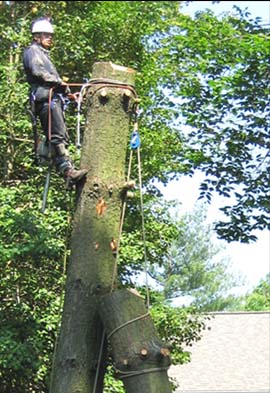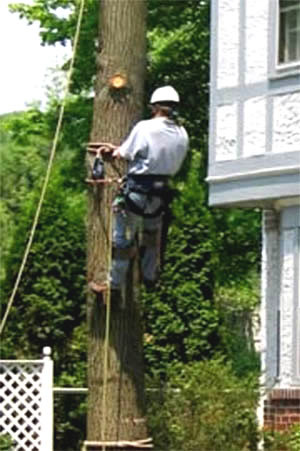The Friction Hitch: this is the knot that climbers use to control their position on the rope, when using doubled rope technique. All new school climbers use some sort of advanced cordage and knot, while old school climbers simply tie the “working end” of their line to their saddle, leaving a 3’-4’ tail, and then use that tail to tie a taut line hitch or prussic to the standing end of the line. This old school climbing system is awkward and clumsy in that is requires the use of two hands to advance the hitch, and the hitch has a tendency to lock-up or jam, making it very hard to release to descend.
The use of a slack tending micro-pulley in combination with an advanced friction allows the new school climber to take the slack out of his climbing line with one hand, or get belayed from the ground, so that slack is taken out of his system as he ascends. This is far faster, easier, and safer, making movement through the entire canopy more like fun than hard work.
Most old school climbers don’t even know the name of the knot they use to use as a friction hitch nor will they know what is meant when they are asked “what kind of friction hitch do you use”. Whenever I talk to another climber, one of the first questions I ask is “what type of friction hitch do you use”. When they don’t even know what that means, which is the case for the vast majority, I know they are old school at best.
New school climbers may use several types of friction hitches and vary the cordage used and the number of wraps and turns used to form the knots, depending on the amount of friction in the overhead tie in point, and their particular climbing style, which will often change depending on the type of work that is being performed. All climbers in ISA tree climbing competitions use advanced friction hitches and footlocking. Use and proficiency in these techniques is a minimum standard of competence in modern tree care. If your climber doesn’t know how to footlock, or isn’t using an advanced friction hitch, chances are pretty good that he is a hack, whether he knows it or not.
Tie in point: this refers to the overhead crotch or “false crotch” that is used to support the climbing line. New school climbers will use an extremely high tie in point, because the higher the line is placed in the tree, the easier it is to move throughout the canopy and reach the branch tips. The importance of picking a good high tie in point cannot be over-emphasized to apprentice climbers. New school climbers are able to set their climbing lines in nice high branch unions from the ground, so they are well positioned from the time they begin their ascents. Branch unions as small as 2.5”-3” in diameter can be used safely, giving the new school climber easy access to the highest limbs of the tree.
New school climbers will often use a mechanical device called a “friction saver” or “false crotch” to reduce the friction on the climbing line as the climber moves both up and down in the canopy. This makes movement throughout the canopy mush smoother and easier, which is especially important on pruning big trees as they require constant movement and repositioning. On a wide spread canopy a new school climber may work one section, then move his tie in point to another branch union elsewhere in the canopy to have a better position to work another section of the tree.
Old school climbers tend to set their climbing lines in lower, and therefore larger, branch unions, sometimes using 6”-12”+ diameter branches. This gives the climbing line a poor overhead angle, making movement much more tedious and restricted. The added friction of the bark on the climbing line in such large branch unions makes it harder and more physically demanding to move either up or down. This leads to fatigue and frustration and results in the tendency to take inappropriate shortcuts, often performing inferior and unsafe tree work.



